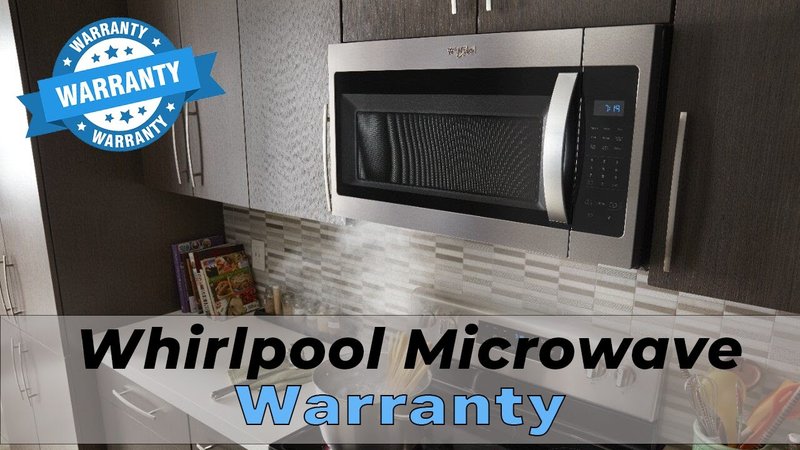
Imagine you’ve just bought a shiny new Whirlpool microwave—a kitchen superhero promising to zap your meals in seconds. Now, picture the disappointment if it suddenly stops heating or starts making strange noises. It’s frustrating, right? But here’s the thing: that’s exactly what a warranty is for. It’s like the safety net under your microwave’s tightrope act, ready to catch you if something goes wrong.
Claiming a warranty on a Whirlpool microwave might sound complicated, but it’s a lot simpler than you think. Think of it as a conversation with a helpful friend who’s ready to guide you through the process step-by-step. Let me explain how you can smoothly navigate this journey—from understanding your warranty to successfully getting your microwave fixed or replaced—without breaking a sweat.
Understanding Your Whirlpool Microwave Warranty
First off, it’s crucial to know exactly what your Whirlpool microwave warranty covers. Usually, Whirlpool offers a one-year limited warranty on parts and labor for their microwaves. This means if your microwave breaks down because of a manufacturing fault within that year, Whirlpool should cover the repair or replacement costs. But, here’s the catch: this warranty doesn’t extend to damage caused by misuse, accidents, or normal wear and tear.
So, what does this really mean for you? Think of the warranty as a promise that your microwave won’t quit on you right away due to faulty parts or poor craftsmanship. If your microwave suddenly stops working properly without you having dropped it or spilled something inside, you’re likely covered. However, if you’ve gotten a dent from an unfortunate kitchen mishap, that would fall outside the warranty’s protection.
Keep in mind that different models might have slightly different warranty terms. Your best bet is to check the warranty booklet that came with your microwave or visit Whirlpool’s official website. This way, you won’t be caught off guard. A little homework now can save you a lot of hassle later.
Gathering Essential Information Before Claiming
You might be wondering, what exactly do I need before I start the warranty claim process? Honestly, having the right information at your fingertips is like having a clear map before starting a trip. It speeds things up and makes communication way smoother.
Here’s what you should gather:
- Proof of purchase: Your receipt or order confirmation shows when and where you bought the microwave.
- Model and serial number: These unique codes identify your specific microwave. You’ll usually find them on a label inside the microwave door or on the back.
- Warranty card or booklet: This might include the warranty terms and instructions.
- Description of the problem: Be ready to explain what’s wrong, when it started, and any troubleshooting you’ve tried.
Having this info ready when you contact Whirlpool’s customer service—or the store where you purchased the unit—makes the process easier and faster. It’s like going to the doctor with all your symptoms clearly noted instead of guessing what’s wrong.
How To Contact Whirlpool For Warranty Support
Now that your paperwork is in order, you might ask, “How do I actually get in touch with Whirlpool?” Multiple avenues exist, and choosing the right one depends on what’s most convenient and efficient for you.
Here’s a quick breakdown:
- Phone Support: Calling Whirlpool’s customer service hotline is often the fastest way to start a claim. A live person can guide you through troubleshooting or direct you to an authorized service center.
- Online Claim Form: Whirlpool’s website offers a warranty claim form where you can enter your microwave’s details and issue. This is handy if you prefer typing over talking.
- Retailer Contact: If you bought your microwave from a store, sometimes it’s easier to contact them first. They can either handle the warranty process or advise you on next steps.
One thing to remember — keep a record of every conversation or email. Note names, dates, and what was discussed. This comes in handy if you need to follow up or escalate the issue later. It’s kind of like keeping a diary of your warranty journey.
What To Expect During The Warranty Claim Process
Here’s the part where most people feel unsure: what really happens after you submit a warranty claim? Let me explain so you feel more confident.
Once Whirlpool or an authorized service provider receives your claim, they typically begin with troubleshooting. This might involve asking you to perform simple resets or checks—like unplugging the microwave for a few minutes or making sure the door is closing correctly. Sometimes, issues can be fixed with a quick reset or by re-syncing components.
If those steps don’t solve the problem, Whirlpool usually sends a technician or asks you to bring the microwave to an authorized repair center. The technician will diagnose the problem and either repair the faulty part or replace the microwave if repair isn’t feasible. Throughout this process, workmanship and parts under warranty are covered at no cost to you.
Patience is key here. Sometimes repairs or replacements take a bit longer than expected, especially if specific parts need to be ordered. But knowing you’re knee-deep in the warranty process should give you peace of mind.
Common Issues Covered and Troubleshooting Tips Before Claiming
Before diving into a warranty claim, it’s worth checking a few simple things. Here’s the deal: some “problems” might just be easy fixes, saving you time and frustration.
Here are common Whirlpool microwave issues often covered by warranty:
- Microwave not heating: Could be a faulty diode or magnetron.
- Turntable not spinning: Sometimes the motor or coupling needs replacement.
- Control panel unresponsive: This can be a defect in the control board or keypad.
But before you claim, try these troubleshooting steps:
- Unplug the microwave for 5 minutes, then plug it back in to reset the system.
- Check the door latch—if it’s not fully closing, the microwave won’t start as a safety measure.
- Ensure the power outlet works by testing it with another device.
If these don’t help, your problem might be one that falls under warranty coverage. At least you’ll have ruled out simple issues.
Tips For A Smooth Warranty Experience
Honestly, claiming a warranty isn’t always the most exciting task, but a little preparation can make it smoother. Think of it as preparing for a trip where you want to avoid surprises.
Here’s what helps:
- Keep your receipt safe: No proof of purchase usually means no warranty.
- Register your microwave with Whirlpool: Some models let you register online—this can speed up claims.
- Follow the instructions carefully: For example, always use your microwave as the manual describes to avoid voiding the warranty.
- Document everything: Take notes on conversations, repairs made, and parts replaced.
Following these tips means when it’s time to claim your warranty, you’ll feel a lot more in control—and less like you’re lost in a maze.
Alternatives When Warranty Doesn’t Cover The Issue
Sometimes, despite your best efforts, your warranty claim might be denied. Maybe the microwave’s problem is due to accidental damage or it’s outside the warranty period. So, what do you do?
Here are a few ideas:
- Authorized Repairs: You can still get your microwave fixed by Whirlpool-authorized service centers, but you’ll need to pay out of pocket.
- Local Repair Shops: Some independent repair shops specialize in microwaves and might offer more affordable fixes.
- Replacement Options: If the repair cost seems too high, it might be worth considering a new microwave. Look for models with extended warranties or better durability.
You could also try troubleshooting forums or Whirlpool support communities online—sometimes a fix can be as simple as a reset or replacing a battery in the remote control (if your model uses one).
Closing Thoughts
Claiming a warranty for your Whirlpool microwave doesn’t have to feel like decoding a secret message. With a little patience, proper info, and some simple troubleshooting, you can usually get your microwave back to zapping in no time. Remember, the warranty is there to protect you from faulty products—not from everyday wear or accidents—so understanding its limits helps manage expectations.
Next time your microwave misbehaves, you’ll know exactly where the serial number is, how to describe the problem, and what steps to take. And if things get tricky? Whirlpool’s customer service is just a call or click away, ready to help you through it. That kitchen superhero of yours deserves a bit of care, after all.
